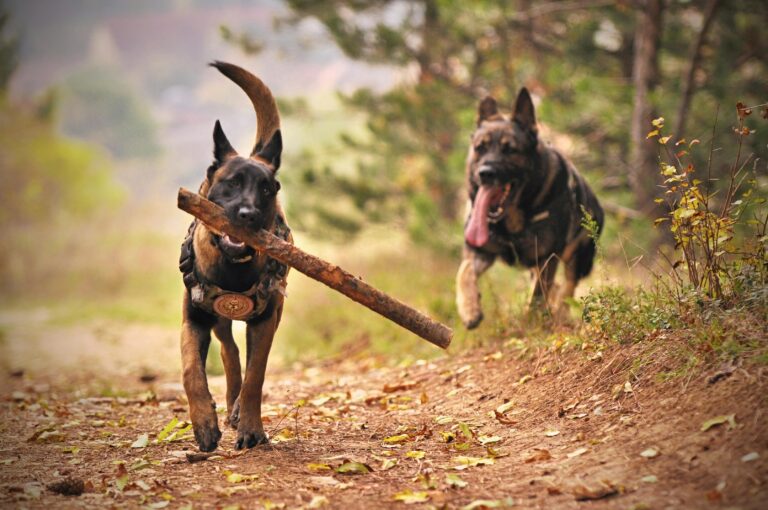Training Tips for Multi-Dog Homes
Having more than one dog in your household can be incredibly rewarding. They provide companionship for each other, encourage exercise, and bring twice the joy. But with that joy can also come challenges. From food guarding to leash chaos, managing a multi-dog household requires structure, leadership, and consistency.
The good news is that with the right strategies, you can create harmony in your home while reinforcing obedience for all of your dogs.
Why Structure Matters in Multi-Dog Homes
Without structure, dogs often compete for attention, resources, or space. This can lead to barking, pushiness, or even fights. Dogs look to their owners for guidance. When you provide leadership, it prevents power struggles and ensures your dogs coexist peacefully.
Consistency is key. If one dog gets away with behaviors like jumping or pulling while the other is corrected, confusion will grow. Setting the same rules for all dogs builds balance and trust.
Train Each Dog Individually First
Before expecting dogs to work together, make sure each one has a strong obedience foundation on their own. Practice commands like sit, down, place, and recall with each dog separately.
When each dog understands expectations individually, you can begin pairing them for short group training sessions. This prevents one dog from distracting or copying the bad habits of the other.
Our Basic & Advanced Obedience Program is ideal for multi-dog households. It creates reliable skills for each dog while preparing them to listen in high-distraction situations.
Explore our Basic & Advanced Obedience Program
Establish Clear Rules Around Resources
Food, toys, and even human attention can all become sources of competition. Prevent problems before they start by creating clear rules.
Practical tips:
- Feed dogs in separate areas to avoid food aggression.
- Teach impulse control by having each dog sit before receiving meals or treats.
- Rotate toys to prevent possessiveness.
- Avoid giving one dog special privileges without requiring obedience from all.
By controlling resources, you show leadership and prevent conflicts.
Use the “Place” Command to Create Calm
Chaos often happens when multiple dogs try to crowd around guests, doors, or family members. Teaching each dog to go to a designated spot gives you control over the environment.
Our blog on how to train a reliable place command shows how this skill creates calm in hectic moments. For multi-dog homes, it is even more valuable because each dog learns to hold position until released.
Walk Dogs Separately Before Together
Walking multiple dogs can feel like a tangled mess if leash skills are not solid. Start by training each dog individually on loose leash walking. Once both dogs can walk calmly on their own, pair them together.
If pulling or competition starts, go back to individual walks until consistency returns. Structured walks not only burn energy but also reinforce your leadership.
Prevent Pack Mentality Problems
When dogs live together, they can form a “pack” dynamic that sometimes overrides their obedience to you. This is especially common if they hype each other up when barking at strangers, chasing squirrels, or playing rough.
Break up overly intense play sessions before they escalate. Call each dog to you, reward calm behavior, and then release them back to play. This teaches that you, not the pack, set the rules.
Make Leash Time Fun, Not Frenzied
Leash time should build engagement instead of competition. Short focus games keep everyone thinking and listening.
Try these quick drills:
- Name game, say a dog’s name and reward eye contact, then rotate to the next dog.
- Turn cues, walk, say “this way,” and turn, reward both dogs for following smoothly.
- Sit for greetings, one dog sits while the other practices calmly waiting, then swap.
For more ideas that translate perfectly to multi-dog walks, check out our post on games and drills to make leash training fun and effective.
Sample Daily Routine for Multi-Dog Homes
Structure is easier to keep when the day has a rhythm.
- Morning: Individual 5 minute obedience sessions, then short separate walks.
- Midday: Place practice while you handle chores or work calls.
- Afternoon: Supervised play, interrupt and reset if it gets too rowdy.
- Evening: Group walk if both dogs earned it, practice sits at curbs and place during dinner.
- Night: Calm decompression time in crates or on beds before lights out.
Expert Resource: Reward Systems That Scale To Multiple Dogs
The AKC’s overview of Training With Rewards shows how to use food, toys, and life rewards effectively. In multi-dog homes, clear reward rules prevent resource guarding and keep sessions orderly, for example, one reward per rep, name it, pay it, then reset.
Final Thoughts
A multi-dog home can be full of love, laughter, and loyalty. But without training and structure, it can also become chaotic. By training each dog individually, setting clear rules, and reinforcing obedience daily, you’ll create a calm, balanced household where every dog thrives.
Need help creating harmony with your dogs? Our trainers specialize in helping families with more than one dog.
Contact Off Leash K9 Training Dayton today to bring balance and obedience to your multi-dog household.


